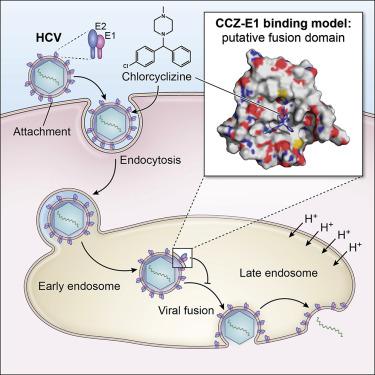Cell Chemical Biology ( IF 8.6 ) Pub Date : 2020-05-07 , DOI: 10.1016/j.chembiol.2020.04.006 Zongyi Hu 1 , Adam Rolt 1 , Xin Hu 2 , Christopher D Ma 1 , Derek J Le 1 , Seung Bum Park 1 , Michael Houghton 3 , Noel Southall 2 , D Eric Anderson 4 , Daniel C Talley 2 , John R Lloyd 4 , Juan C Marugan 2 , T Jake Liang 1

|
Chlorcyclizine (CCZ) is a potent hepatitis C virus (HCV) entry inhibitor, but its molecular mechanism is unknown. Here, we show that CCZ directly targets the fusion peptide of HCV E1 and interferes with the fusion process. Generation of CCZ resistance-associated substitutions of HCV in vitro revealed six missense mutations in the HCV E1 protein, five being in the putative fusion peptide. A viral fusion assay demonstrated that CCZ blocked HCV entry at the membrane fusion step and that the mutant viruses acquired resistance to CCZ's action in blocking membrane fusion. UV cross-linking of photoactivatable CCZ-diazirine-biotin in both HCV-infected cells and recombinant HCV E1/E2 protein demonstrated direct binding to HCV E1 glycoprotein. Mass spectrometry analysis revealed that CCZ cross-linked to an E1 sequence adjacent to the putative fusion peptide. Docking simulations demonstrate a putative binding model, wherein CCZ binds to a hydrophobic pocket of HCV E1 and forms extensive interactions with the fusion peptide.
中文翻译:

氯霉素通过直接靶向HCV包膜糖蛋白1抑制丙型肝炎病毒进入的病毒融合。
氯霉素(CCZ)是一种有效的丙型肝炎病毒(HCV)进入抑制剂,但其分子机制尚不清楚。在这里,我们显示CCZ直接靶向HCV E1的融合肽并干扰融合过程。在体外产生CCZ抗性相关的HCV取代HCV E1蛋白发现6个错义突变,其中5个位于推定的融合肽中。病毒融合试验表明,CCZ在膜融合步骤阻止了HCV进入,并且突变病毒获得了对CCZ在阻止膜融合中的作用的抗性。在HCV感染的细胞和重组HCV E1 / E2蛋白中,可光激活的CCZ-二氮杂胺-生物素的UV交联表现出与HCV E1糖蛋白的直接结合。质谱分析表明,CCZ交联至与假定融合肽相邻的E1序列。对接模拟证明了一种推定的结合模型,其中CCZ与HCV E1的疏水口袋结合,并与融合肽形成广泛的相互作用。


























 京公网安备 11010802027423号
京公网安备 11010802027423号